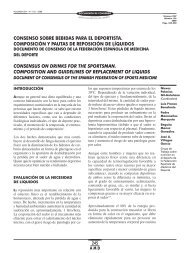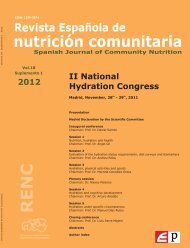athletes' medical information - Coca-Cola
athletes' medical information - Coca-Cola
athletes' medical information - Coca-Cola
Create successful ePaper yourself
Turn your PDF publications into a flip-book with our unique Google optimized e-Paper software.
athletes’ <strong>medical</strong> <strong>information</strong><br />
Energy needs<br />
Energy intake sets the “budget” from which an<br />
athlete must meet their needs for carbohydrate,<br />
protein and fat, as well as the range of foods<br />
that provide vitamins, minerals and other<br />
health-promoting dietary factors.<br />
An athlete’s energy requirements are made<br />
up of several components: baseline metabolic<br />
needs (such as the energy required to support<br />
cellular maintenance, temperature regulation<br />
and immune health), growth and physical<br />
activity. Energy expended in one of these<br />
processes is not available for others, so the diet<br />
must provide sufficient energy to meet the<br />
needs of all essential functions. Physical activity<br />
– or in the case of an athlete, the intensity,<br />
duration and frequency of training sessions and<br />
competitions – will play a strong role in<br />
determining daily energy requirements.<br />
When daily intake of food energy from<br />
carbohydrate, fat, protein and alcohol is equal to<br />
energy expenditure, the athlete is said to be in<br />
energy balance.<br />
Energy balance = Energy intake – Energy<br />
expenditure<br />
This means there is neither a net loss nor<br />
gain from the body’s energy stores of fat,<br />
protein and carbohydrate. These energy stores<br />
play a number of important roles related to<br />
exercise performance, contributing to:<br />
An athlete’s size and physique (e.g., body fat<br />
stores and muscle mass)<br />
Function (e.g., muscle mass)<br />
Fuel for exercise (e.g., muscle and liver<br />
glycogen stores)<br />
Athletes often want to change their energy<br />
balance, either to produce an energy deficit<br />
(principally to reduce the size of body fat stores)<br />
or to achieve an energy surplus (principally to<br />
support growth or support the gain of muscle<br />
mass). This can be done either by altering<br />
energy intake, energy expenditure or both<br />
components.<br />
However, an important new concept is that<br />
of energy availability. This is defined as the<br />
energy that is available to the body after the<br />
energy cost of physical activity has been<br />
deducted from daily energy intake. Energy<br />
availability is, therefore, the amount of energy<br />
that can be expended to look after the body’s<br />
physiological needs.<br />
Energy availability = Energy intake – Energy<br />
cost of training/competition<br />
The body can cope with a small drop in<br />
energy availability, but if it becomes too great,<br />
this will compromise its ability to undertake the<br />
processes needed for optimum health and<br />
function. An example of adequate energy<br />
availability is provided in the table below.<br />
We now recognise that many health and<br />
performance problems commonly seen in<br />
athletes are associated with low energy<br />
availability – these include menstrual<br />
disturbances in female athletes, reduced basal<br />
metabolic rate, compromised immunity, poor<br />
hormonal function and impaired bone density.<br />
Although any reduction in energy availability<br />
has some effect on the body, researchers have<br />
identified a threshold below which the<br />
consequences are particularly harmful. This is<br />
6<br />
12-113-COC_Paralymics_Booklet_20120718.indd 6<br />
7/18/12 4:28 PM

















